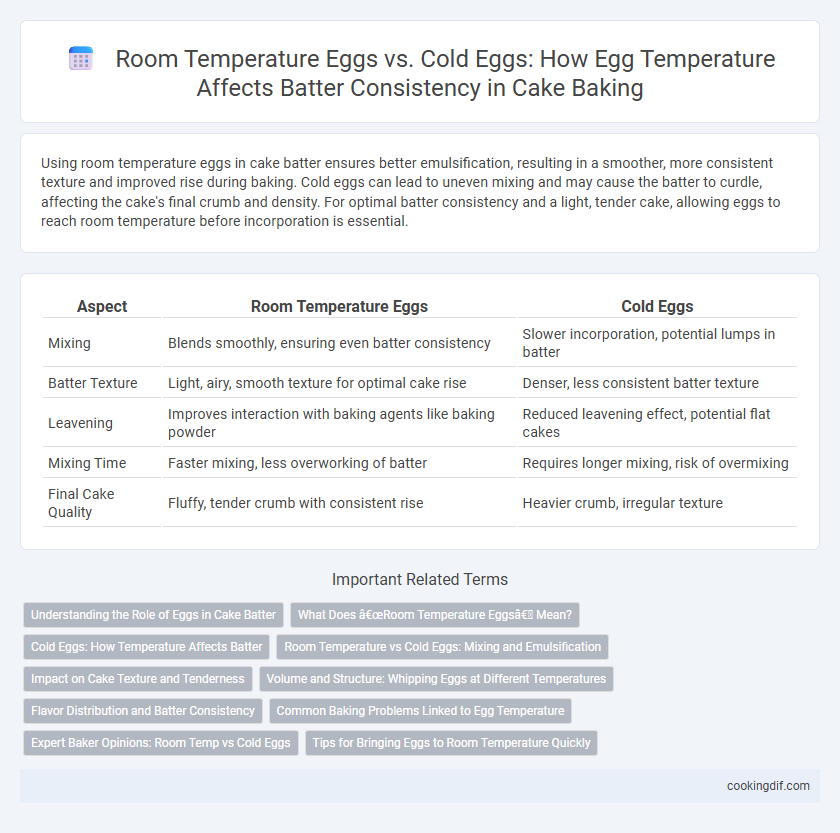Using room temperature eggs in cake batter ensures better emulsification, resulting in a smoother, more consistent texture and improved rise during baking. Cold eggs can lead to uneven mixing and may cause the batter to curdle, affecting the cake's final crumb and density. For optimal batter consistency and a light, tender cake, allowing eggs to reach room temperature before incorporation is essential.
Table of Comparison
| Aspect | Room Temperature Eggs | Cold Eggs |
|---|---|---|
| Mixing | Blends smoothly, ensuring even batter consistency | Slower incorporation, potential lumps in batter |
| Batter Texture | Light, airy, smooth texture for optimal cake rise | Denser, less consistent batter texture |
| Leavening | Improves interaction with baking agents like baking powder | Reduced leavening effect, potential flat cakes |
| Mixing Time | Faster mixing, less overworking of batter | Requires longer mixing, risk of overmixing |
| Final Cake Quality | Fluffy, tender crumb with consistent rise | Heavier crumb, irregular texture |
Understanding the Role of Eggs in Cake Batter
Eggs play a crucial role in cake batter by providing structure, moisture, and emulsification, which together ensure a smooth and stable mixture. Room temperature eggs blend more easily with fats and sugars, promoting a uniform batter consistency that traps air effectively for better rise and texture. Using cold eggs can result in a lumpy batter, compromising the cake's lightness and even baking.
What Does “Room Temperature Eggs” Mean?
Room temperature eggs typically mean eggs that have been left out of the refrigerator for about 30 to 60 minutes, reaching approximately 68degF to 72degF (20degC to 22degC). Using room temperature eggs in cake batter ensures better emulsification with fats and sugars, resulting in a smoother, more uniform batter consistency. Cold eggs can cause the batter to curdle and affect rise and texture, while eggs at room temperature blend more easily, promoting better volume and crumb in cakes.
Cold Eggs: How Temperature Affects Batter
Cold eggs lower the overall batter temperature, which can slow down the emulsification process, resulting in a denser and less smooth cake texture. Ingredients in cold eggs cause the fats to firm up, reducing the batter's ability to trap air and leading to less volume and lighter crumb structure. Using cold eggs often requires longer mixing times to achieve a uniform consistency, impacting the final rise and moisture retention of the cake.
Room Temperature vs Cold Eggs: Mixing and Emulsification
Room temperature eggs mix more evenly into batter, promoting better emulsification between fats and liquids for a smoother texture. Cold eggs can cause uneven mixing, resulting in a curdled batter that negatively affects cake rise and crumb structure. Using eggs at room temperature maximizes volume and consistency by ensuring ingredients blend seamlessly during the creaming process.
Impact on Cake Texture and Tenderness
Room temperature eggs blend more uniformly into cake batter, promoting a smooth, consistent texture that enhances overall tenderness. Cold eggs can cause the batter to seize or become lumpy, leading to uneven crumb structure and potential dryness in the final cake. Maintaining eggs at room temperature ensures optimal emulsification of fats and liquids, resulting in a tender, moist cake with an even rise.
Volume and Structure: Whipping Eggs at Different Temperatures
Room temperature eggs whip more efficiently, trapping air to increase volume and create a lighter, fluffier cake structure compared to cold eggs that resist aeration. The proteins in room temperature eggs unfold better during beating, stabilizing the foam and enhancing batter consistency. Using cold eggs often results in denser batter and reduced rise due to less effective volume incorporation.
Flavor Distribution and Batter Consistency
Using room temperature eggs in cake batter improves flavor distribution by allowing ingredients to blend more uniformly, resulting in a smoother and more consistent texture. Cold eggs can cause the fat in the batter to solidify, leading to uneven mixing and a denser crumb. Maintaining eggs at room temperature enhances emulsification, promoting better rise and a tender, evenly flavored cake.
Common Baking Problems Linked to Egg Temperature
Using room temperature eggs in cake batter improves emulsification, resulting in a smoother texture and better rise. Cold eggs can cause fat to solidify, leading to uneven mixing, lumps, and dense cakes. Common baking problems linked to egg temperature include poor volume, uneven crumb, and inconsistent batter consistency.
Expert Baker Opinions: Room Temp vs Cold Eggs
Expert bakers emphasize that room temperature eggs blend more smoothly into cake batter, promoting better emulsification and a consistent texture. Cold eggs can cause the batter to curdle or become lumpy, hindering rise and resulting in a denser crumb. For optimal cake consistency and even baking, professional pastry chefs recommend using eggs at room temperature.
Tips for Bringing Eggs to Room Temperature Quickly
For optimal batter consistency, warming cold eggs quickly can be achieved by placing them in a bowl of warm water for about 5 to 10 minutes, which helps them blend more smoothly with other ingredients. Using eggs at room temperature ensures better emulsification, resulting in a lighter, fluffier cake texture. Avoid microwaving eggs, as this can affect their structural integrity and lead to uneven batter consistency.
Room Temperature Eggs vs Cold Eggs for batter consistency Infographic

 cookingdif.com
cookingdif.com